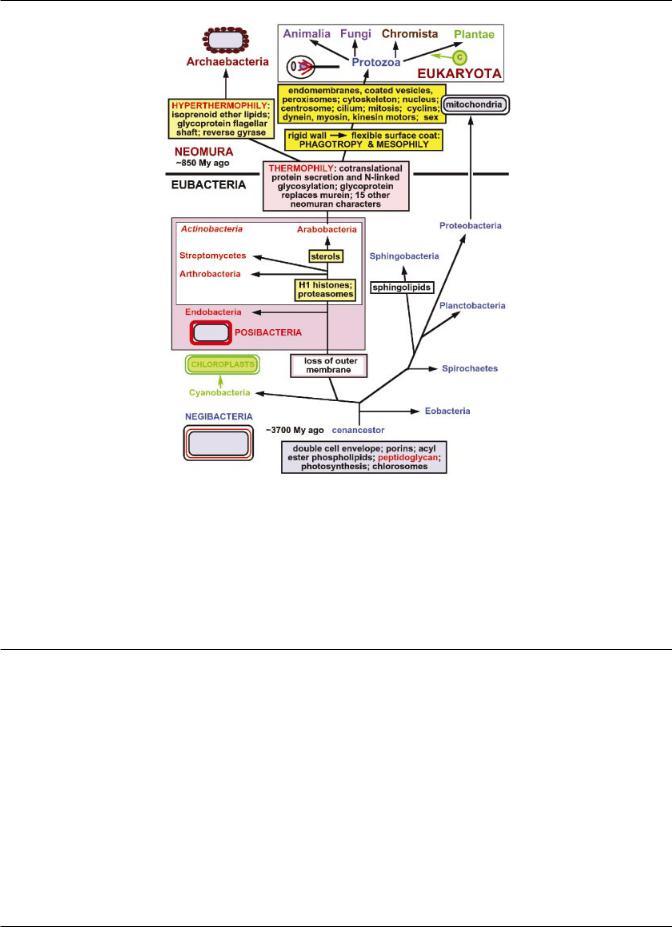
297.full
.pdf
International Journal of Systematic and Evolutionary Microbiology (2002), 52, 297±354 |
DOI: 10.1099/ijs.0.02058-0 |
|
|
The phagotrophic origin of eukaryotes and phylogenetic classi®cation of Protozoa
Department of Zoology,
University of Oxford, South
Parks Road, Oxford OX1 3PS,
UK
T. Cavalier-Smith
Tel : -44 1865 281065. Fax : -44 1865 281310. e-mail: tom.cavalier-smith!zoo.ox.ac.uk
Eukaryotes and archaebacteria form the clade neomura and are sisters, as shown decisively by genes fragmented only in archaebacteria and by many sequence trees. This sisterhood refutes all theories that eukaryotes originated by merging an archaebacterium and an a-proteobacterium, which also fail to account for numerous features shared speci®cally by eukaryotes and actinobacteria. I revise the phagotrophy theory of eukaryote origins by arguing that the essentially autogenous origins of most eukaryotic cell properties (phagotrophy, endomembrane system including peroxisomes, cytoskeleton, nucleus, mitosis and sex) partially overlapped and were synergistic with the symbiogenetic origin of mitochondria from an a-proteobacterium. These radical innovations occurred in a derivative of the neomuran common ancestor, which itself had evolved immediately prior to the divergence of eukaryotes and archaebacteria by drastic alterations to its eubacterial ancestor, an actinobacterial posibacterium able to make sterols, by replacing murein peptidoglycan by N-linked glycoproteins and a multitude of other shared neomuran novelties. The conversion of the rigid neomuran wall into a ¯exible surface coat and the associated origin of phagotrophy were instrumental in the evolution of the endomembrane system, cytoskeleton, nuclear organization and division and sexual life-cycles. Cilia evolved not by symbiogenesis but by autogenous specialization of the cytoskeleton. I argue that the ancestral eukaryote was uniciliate with a single centriole (unikont) and a simple centrosomal cone of microtubules, as in the aerobic amoebozoan zoo¯agellate Phalansterium. I infer the root of the eukaryote tree at the divergence between opisthokonts (animals, Choanozoa, fungi) with a single posterior cilium and all other eukaryotes, designated `anterokonts' because of the ancestral presence of an anterior cilium. Anterokonts comprise the Amoebozoa, which may be ancestrally unikont, and a vast ancestrally biciliate clade, named `bikonts'. The apparently con¯icting rRNA and protein trees can be reconciled with each other and this ultrastructural interpretation if longbranch distortions, some mechanistically explicable, are allowed for. Bikonts comprise two groups: cortico¯agellates, with a younger anterior cilium, no centrosomal cone and ancestrally a semi-rigid cell cortex with a microtubular band on either side of the posterior mature centriole; and Rhizaria [a new infrakingdom comprising Cercozoa (now including Ascetosporea classis nov.), Retaria phylum nov., Heliozoa and Apusozoa phylum nov.], having a centrosomal cone or radiating microtubules and two microtubular roots and a soft surface, frequently with reticulopodia. Cortico¯agellates comprise photokaryotes (Plantae and chromalveolates, both ancestrally with cortical alveoli) and Excavata (a new protozoan infrakingdom comprising Loukozoa, Discicristata and Archezoa, ancestrally with three microtubular roots). All basal
.................................................................................................................................................................................................................................................................................................................
This paper is an elaboration of part of an invited presentation to the XIIIth meeting of the International Society for Evolutionary Protistology in Ceske! Bude)jovice, Czech Republic, 31 July±4 August 2000.
Two notes added in proof are available as supplementary materials in IJSEM Online (http://ijs.sgmjournals.org/).
Abbreviations: snoRNP, small nucleolar ribonucleoprotein; SRP, signal recognition particle.
02058 # 2002 IUMS Printed in Great Britain |
297 |

T. Cavalier-Smith
eukaryotic radiations were of mitochondrial aerobes; hydrogenosomes evolved polyphyletically from mitochondria long afterwards, the persistence of their double envelope long after their genomes disappeared being a striking instance of membrane heredity. I discuss the relationship between the 13 protozoan phyla recognized here and revise higher protozoan classi®cation by updating as subkingdoms Lankester's 1878 division of Protozoa into Corticata (Excavata, Alveolata; with prominent cortical microtubules and ancestrally localized cytostome ± the Parabasalia probably secondarily internalized the cytoskeleton) and Gymnomyxa [infrakingdoms Sarcomastigota (Choanozoa, Amoebozoa) and Rhizaria; both ancestrally with a non-cortical cytoskeleton of radiating singlet microtubules and a relatively soft cell surface with diffused feeding]. As the eukaryote root almost certainly lies within Gymnomyxa, probably among the Sarcomastigota, Corticata are derived. Following the single symbiogenetic origin of chloroplasts in a cortico¯agellate host with cortical alveoli, this ancestral plant radiated rapidly into glaucophytes, green plants and red algae. Secondary symbiogeneses subsequently transferred plastids laterally into different hosts, making yet more complex cell
chimaeras ± probably only thrice: from a red alga to the cortico¯agellate ancestor of chromalveolates (Chromista plus Alveolata), from green algae to a secondarily uniciliate cercozoan to form chlorarachneans and independently to a biciliate excavate to yield photosynthetic euglenoids. Tertiary symbiogenesis involving eukaryotic algal symbionts replaced peridinin-containing plastids in two or three dino¯agellate lineages, but yielded no major novel groups. The origin and well-resolved primary bifurcation of eukaryotes probably occurred in the Cryogenian Period, about 850 million years ago, much more recently than suggested by unwarranted backward extrapolations of molecular `clocks' or dubious interpretations as `eukaryotic' of earlier large microbial fossils or still more ancient steranes. The origin of chloroplasts and the symbiogenetic incorporation of a red alga into a cortico¯agellate to create chromalveolates may both have occurred in a big bang after the Varangerian snowball Earth melted about 580 million years ago, thereby stimulating the ensuing Cambrian explosion of animals and protists in the form of simultaneous, poorly resolved opisthokont and anterokont radiations.
Keywords : Corticata, Rhizaria, Excavata, centriolar roots of bikonts, Amoebozoa and opisthokonts, symbiogenetic origin of mitochondria
Introduction: revising the neomuran theory of the origin of eukaryotic cells
In 1987, I published seven papers that together developed an integrated view of cell evolution, ranging from the origin of the ®rst bacterium, a Gram-negative eubacterium (negibacterium; Cavalier-Smith, 1987a), and the nature of bacterial DNA segregation (Cava- lier-Smith, 1987b), through the origins of archaebacteria (Cavalier-Smith, 1987c) and eukaryotes (Cava- lier-Smith, 1987c, d) and the symbiogenetic origins of mitochondria and chloroplasts and their secondary lateral transfers (Cavalier-Smith, 1987e) to the origins and diversi®cation of plant (Cavalier-Smith, 1987f) and animal and fungal cells (Cavalier-Smith, 1987g). Central to those publications was the then novel view that eukaryotes were sisters to archaebacteria and that both diverged from a common ancestor that itself arose by the drastic evolutionary transformation of a
Gram-positive eubacterium. I argued that the most important change in this radical transformation of a eubacterium into the common ancestor of eukaryotes and archaebacteria was the replacement of the eubacterial peptidoglycan murein by N-linked glycoprotein and that the concomitant changes in the replication, transcription and translation machinery were of comparatively trivial evolutionary signi®cance. I therefore called the postulated clade comprising archaebacteria and eukaryotes `neomura' (meaning ` new walls ') and will continue this usage here. I further argued that the archaebacteria, though becoming adapted to hot, acid environments by replacing the eubacterial acyl ester lipids by prenyl ether lipids, used the new glycoproteins as a rigid cell wall (exoskeleton) and therefore retained the ancestral bacterial cell division and generally bacterial cell and chromosomal organization. Though chemically radically changed, they remained prokaryotic because, like other bacteria, they retained an
298 |
International Journal of Systematic and Evolutionary Microbiology 52 |

Origins of eukaryotes and protozoan classi®cation
exoskeleton, which prevented more radical innovation. Their pre-eukaryote sisters, in striking contrast, by using the new glycoproteins to develop a more ¯exible surface coat, were able to evolve phagocytosis for the ®rst time in the history of life, which necessarily led to the rapid origin of the eukaryotic cytoskeleton, mitosis and endomembrane system and ultimately the nucleus, cilia and sex. Phagotrophy was also the prerequisite for the uptake of the symbiotic eubacterial ancestors of mitochondria and chloroplasts. I also interpreted the fossil record as showing that eukaryotes were less than half as old as eubacteria and emphasized that, according to the neomuran theory, archaebacteria must be equally young and not a primordial group as has often been supposed to be the case. A shared neomuran character that I particularly stressed was the cotranslational N-linked glycosylation of cell-surface proteins, which o ered special insights into the origin of the eukaryotic endomembrane system (CavalierSmith, 1987c).
The present paper revises this neomuran theory of the origin of the eukaryotic cell, re-emphasizing the role of phagotrophy in the origin of eukaryotes (CavalierSmith, 1975, 1987c), in the light of recent substantial phylogenetic advances, notably the evidence that mitochondria were already present in the common ancestor of all extant eukaryotes (Cavalier-Smith, 1998a, 2000a; Embley & Hirt, 1998 ; Gupta, 1998a; Keeling, 1998; Keeling & McFadden, 1998; Roger, 1999) and that all anaerobic eukaryotes have evolved by the loss of mitochondria or their conversion into hydrogenosomes (Cavalier-Smith, 1987e; Muller$ & Martin, 1999). My detailed explanations of the origins of the 18 suites of shared neomuran characters (many more than were apparent in 1987) and of the many fewer unique archaebacterial characters have been presented in a separate paper (Cavalier-Smith, 2002a). As that paper also discusses the palaeontological evidence for the origin of neomura ± especially its remarkable recency ± and the widespread misinterpretations of evolutionary artefacts in molecular trees, which have hindered our understanding of the proper positions of their roots, it provides an essential background and broader context to the present one, which focuses speci®cally on the origin and early diversi®cation of the eukaryotic cell. Note that I always use `bacterium' in its proper historical sense as a synonym for `prokaryote', never as a synonym for eubacteria alone (Woese et al., 1990), a thoroughly confusing, highly undesirable and entirely unnecessary change to established usage (Cavalier-Smith, 1992a), which I urge others also to eschew.
If there really are no primitively amitochondrial eukaryotes (Cavalier-Smith, 1998a, 2000a), the simplest explanation of the great mixture of genes of archaebacterial and negibacterial character in eukaryotes (Golding & Gupta, 1995 ; Brown & Doolittle, 1997; Ribeiro & Golding, 1998) is that the negibacterial genes originated from the a-proteobacterium that evolved into the ®rst mitochondrion and that the
archaebacterial-like genes were derived from the host (Cavalier-Smith & Chao, 1996; Cavalier-Smith, 2002a). Postulating a fusion or symbiogenesis between an archaebacterium and a negibacterium prior to the origin of mitochondria (Zillig et al., 1989; Golding & Gupta, 1995; Gupta & Golding, 1996; Lake & Rivera, 1994; Margulis et al., 2000; Moreira & Lo!pez-Garcõ!a, 1998) is entirely unnecessary if the establishment of mitochondria, the endomembrane system and the eukaryotic cytoskeleton were virtually contemporaneous, as I argue here. I maintain that the origin of phagotrophy was the essential prerequisite for all three, for the reasons given in my ®rst discussion of the origin of the nucleus (Cavalier-Smith, 1975). What changed markedly between 1975 and 1987, and less radically since, is the phylogenetic context of these fundamental mechanistic changes.
Prior to my proposal that eukaryotes and archaebacteria are sisters (Cavalier-Smith, 1987c), it had been argued in three seminal papers that archaebacteria were ancestral to eukaryotes (Van Valen & Maiorana, 1980; Searcy et al., 1981; Zillig et al., 1985). I opposed that view primarily because it entailed an independent origin of acyl ester lipids in eubacteria and eukaryotes. One could readily explain the changeover from eubacterial acyl esters to archaebacterial isoprenoid ether lipids as a secondary adaptation for hyperthermophily (Cavalier-Smith, 1987a, c), an explanation that remains valid today (Cavalier-Smith, 2002a). Together with palaeontological evidence for very early eubacterial photosynthesis, it was and is a primary reason for arguing that eubacteria are the paraphyletic ancestors of archaebacteria, not the reverse (CavalierSmith, 1987a, 1991a, b). But, if eukaryotes had evolved substantially before mitochondria, as suggested earlier (Cavalier-Smith, 1983a, b) and rRNA (Vossbrinck & Woese, 1986; Vossbrinck et al., 1987) tempted us to believe (Cavalier-Smith, 1987d), there was no obvious reason why the ®rst eukaryote should have switched from archaebacterial lipids to acyl esters and no obvious means of doing so ; postulating that archaebacteria were sisters rather than ancestors of eukaryotes seemed the obvious solution, since one could argue that their remarkable shared characters all evolved in their immediate common ancestor. If, as now appears to be the case, the ancestral eukaryote was aerobic and had acquired mitochondria prior to its diversi®cation into any extant lineages, this part of my 1987 argument becomes somewhat less compelling. In principle, it would have been possible for the host to have been an archaebacterium and for the prenyl ether lipids to have been replaced by acyl ester lipids derived from the a-proteobacterial ancestor of mitochondria, as Martin (1999) suggested. Such wholesale lipid replacement, if it had occurred, would have been a remarkably complex and improbable evolutionary phenomenon, but it could not be dismissed as altogether impossible. However, recent molecular-phylo- genetic evidence (Cavalier-Smith, 2002a), also brie¯y discussed below, now clearly refutes the idea that
http://ijs.sgmjournals.org |
299 |

T. Cavalier-Smith
archaebacteria are the paraphyletic ancestors of eukaryotes and ®rmly establishes their holophyly. Thus, lipid replacement did not occur during the origin of eukaryotes: essentially all their lipids, including both acyl ester phospholipids and sterols, were probably already present in their actinobacterial ancestor.
The present phagotrophy theory of the essentially simultaneous origin of eukaryotes and mitochondria leaves unchanged most details of the actual transition postulated by the earlier phagotrophy theory of the serial origin of eukaryotes and mitochondria (Cava- lier-Smith, 1987c, e) including their mechanisms and selective advantages, but telescopes them into a single geological period, thus allowing synergy between them and thereby strengthening the overall thesis. In addition to discussing the origin of eukaryotes, I evaluate new evidence bearing on the position of the root of the eukaryote tree and conclude that it lies among aerobic amoebo¯agellates having mitochondria, not among the anaerobic amitochondrial ¯agellates as was thought until recently. Thus, what is most signi®cantly changed in the revised phagotrophy theory is the nature of the ®rst eukaryote ± a chimaeric aerobic unikont ¯agellate resembling the zoo¯agellate Phalan- sterium, instead of a non-chimaeric anaerobic unikont ¯agellate like the pelobiont amoebozoan Mastiga- moeba, as was proposed earlier (Cavalier-Smith, 1991c). Actually, in cell structure, Phalansterium and Mastigamoeba have a lot in common and are probably not cladistically widely separated (Cavalier-Smith, 2000a); indeed, as my own unpublished gammacorrected distance trees actually place Phalansterium within the Amoebozoa, as sister to the Acanthamoebidae, I here transfer Phalansterium into a revised Amoebozoa. Thus, rooting a morphologically based eukaryote tree on either Phalansterium or mastigamoebids would give a very similar tree, broadly consistent with many protein trees but contradicting the rooting (but little of the topology) of rRNA trees. Now, however, with more balanced views of the strengths and weaknesses of molecular trees (Philippe & Adoutte, 1998; Embley & Hirt, 1998; Philippe et al., 2000; Roger, 1999; Stiller & Hall, 1999) in the ascendant, there should be less pressure on us to accept every detail of every rRNA tree as gospel truth. If we also develop a healthier balance between the molecular and the cell-biological or ultrastructural evidence, we can use the latter to help us decide which of the con¯icting molecular trees are more reliable (CavalierSmith, 1981a, 1995a; Taylor, 1999). I shall argue that, although the Amoebozoa are probably very close to the base of the eukaryotic tree, extant or ` crown ' Amoebozoa may actually be holophyletic and that there are probably no extant eukaryotic groups that diverged prior to the fundamental bifurcation between the protozoan ancestors of animals and plants.
New phylogenetic insights, especially those concerning ciliary root evolution discussed here, lead me to revise the higher classi®cation of the kingdom Protozoa in four main ways. Firstly, I place the secondarily
amitochondrial Archezoa (phyla Metamonada and Parabasalia), from which I now exclude oxymonads, as a superphylum within a new infrakingdom Excavata. Excavata also includes Discicristata (phyla Euglenozoa and Percolozoa) and the recently established phylum Loukozoa (Cavalier-Smith, 1999; here augmented by the Oxymonadida and Diphylleiida) and is almost certainly a derived group, not an early branching one, as was previously widely believed. Secondly, I group infrakingdoms Excavata and Alveolata together as subkingdom Corticata (from which the kingdoms Plantae and Chromista are derived). Thirdly, I establish a new subkingdom Gymnomyxa to embrace the majority of the former sarcodine protozoa (i.e. virtually all except the Heterolobosea, which are percolozoa of obvious corticate ancestry) and a variety of soft-surfaced zoo¯agellates with pronounced pseudopodial tendencies within the phyla Cercozoa (into which I transfer the parasitic Ascetosporea and the pseudociliate Stephanopogon), Choanozoa (the closest protozoan relatives of kingdoms Fungi and Animalia; Cavalier-Smith, 1998b), both of which also contain a few former sarcodines, and Apusozoa. Finally, the classi®cation of Gymnomyxa is rationalized by establishing a new infrakingdom Rhizaria that groups the phyla (Cercozoa and Retaria) in which reticulopodia are widespread with the axopodial Heliozoa and the Apusozoa, zoo¯agellates that often have ventral branched pseudopods. I shall present evidence that the Corticata are derived from Gymnomyxa and are cladistically closer to the Rhizaria than to the other gymnomyxan infrakingdom, Sarcomastigota (Amoebozoa, Choanozoa), within which the eukaryote tree is probably rooted.
Intracellular co-evolution: the key to understanding the origin of the eukaryote cell
To understand cell evolution, we must consider evenly the evolution of three things : genomes, membranes and cytoskeletons (Cavalier-Smith, 2001, 2002a). Though I shall discuss aspects of genome and metabolic evolution, I will emphasize the primary importance of membranes and the cell skeleton as providing the environment within which genomes evolve (thus profoundly determining the selective forces acting on them) and their very raison d 'eWtre.
Recent genome sequencing has fostered a simplistic view of organisms as essentially random aggregates of genes and proteins, a molecular-genetic bias worse than the earlier biochemists' oversimpli®cation of them as a `mere bag of enzymes ' ; it forgets both the bag and the skeleton that gives it form and the ability to divide and evolve complexity! Molecular cell biology has taught us that organisms arise only by the co-operation of genes, catalysts, membranes and a cell skeleton (Cavalier-Smith, 1987a, 1991a, b, 2001). The most fundamental events in converting a bacterium into a eukaryote were not generalized changes in the genome or modes of gene expression, but two pro-
300 |
International Journal of Systematic and Evolutionary Microbiology 52 |

Origins of eukaryotes and protozoan classi®cation
found cellular changes : (i) a radical change in membrane topology associated with the origin of coatedvesicle budding and fusion and nuclear pore complexes and (ii) a changeover from a relatively passive exoskeleton (the bacterial cell wall) to an endoskeleton of microtubules and micro®laments associated with the molecular motors dynein, kinesin and myosin. Paradoxically, these innovations fed back onto the genome itself, endowing eukaryotic DNA with a novel function as a nuclear skeleton; viral and bacterial chromosomes are indeed essentially aggregates of genes, but eukaryotic DNA (most of the DNA in the biosphere) is primarily a skeletal polyelectrolyte gel in which genes are only sparsely embedded (Cavalier-Smith & Beaton, 1999).
But I must not oversimplify. The origin of the eukaryote cell was the most complex transformation and elaborate example of quantum evolution (Simpson, 1944) in the history of life. Thousands of DNA mutations caused ten major suites of innovations: (i) origin of the endomembrane system (ER, Golgi and lysosomes) and coated-vesicle budding and fusion, including endocytosis and exocytosis; (ii) origin of the cytoskeleton, centrioles, cilia and associated molecular motors; (iii) origin of the nucleus, nuclear pore complex and trans-envelope protein and RNA transport ; (iv) origin of linear chromosomes with plural replicons, centromeres and telomeres; (v) origin of novel cell-cycle controls and mitotic segregation; (vi) origin of sex (syngamy, nuclear fusion and meiosis); (vii) origin of peroxisomes ; (viii) novel patterns of rRNA processing using small nucleolar ribonucleoproteins (snoRNPs); (ix) origin of mitochondria; and (x) origin of spliceosomal introns. Each of these ten novelties is so complex that it needs its own long review for discussion in the depth that present knowledge of cell biology requires. Here, I concentrate instead on placing them in phylogenetic context and re-empha- sizing the co-evolutionary interconnections between them. I argued previously that the ®rst six innovations arose simultaneously in response to the loss of the bacterial cell wall and the origin of phagotrophy (Cavalier-Smith, 1987c). I argued that each a ected the others and that such intraorganismic molecular coevolution made it counterproductive to attempt to understand the evolution of any one of them in isolation.
The present paper extends the thesis of intracellular co-evolution during the origin of eukaryotes by arguing that the last four innovations also accompanied the others and fed back on some of them (the eighth innovation at least partially preceded the origin of eukaryotes, at least one of the two types of snoRNPs having evolved in the ancestral neomuran; CavalierSmith, 2002a). It also uses advances in understanding ciliary transformation (Moestrup, 2000) to resolve con¯icts between molecular trees and establish with reasonable con®dence the approximate location of the eukaryote root and thus the properties of their cenancestor (latest common ancestor; Fitch & Upper,
1987). The structural evolution of cilia, centrioles and ciliary roots is more central to, and reveals much more about, eukaryote evolution than the sequence-domi- nated community generally realizes.
The unibacterial relatives of eukaryotes
Eukaryotes are sisters of archaebacteria not derived from them
Deciding whether archaebacteria are sisters of eukaryotes or actually ancestral to them is very important for knowing the origin of certain eukaryote genes. Over 40 genes are found in eukaryotes and eubacteria but not apparently in archaebacteria, e.g. Hsp90 (Gupta, 1998a; note that not every gene listed there is truly absent from archaebacteria ± catalase is actually present). If eukaryotes and archaebacteria are sisters (Cavalier-Smith, 1987c, 2002a; Pace et al., 1996), these genes could all have been lost in the common ancestor of archaebacteria, but retained by eukaryotes by vertical inheritance from their neomuran common ancestor. On the other hand, if eukaryotes branched within a paraphyletic archaebacteria, as Gupta (1998a) and Martin & Mu$ller (1998) assume, we should reasonably conclude instead that these genes came from a eubacterium by lateral transfer, possibly simply donated by the proteobacterial ancestor of mitochondria.
Van Valen & Maiorana (1980) proposed that eukaryotes (i.e. the host that enslaved a proteobacterium to make a mitochondrion) evolved from archaebacteria, whereas, for the reasons stated above, I (CavalierSmith, 1987c) postulated instead that archaebacteria are sisters of eukaryotes, but their common ancestor was neither: it was instead a radically changed derivative of a posibacterial mutant, which I shall refer to as a stem neomuran, i.e. one branching prior to the neomuran cenancestor. If eukaryotes evolved from a crown archaebacterium (any descendant of the archaebacterial cenancestor), then they should nest in trees (!) within archaebacteria; but if they evolved from stem archaebacteria (i.e. any before the archaebacterial cenancestor), the sequence trees could not distinguish the two theories as they do not show the phenotype of their common ancestor. This unavoidable cladistic ambiguity of sequence trees, coupled with the fact that existing trees are contradictory, is why neither theory has been unambiguously refuted. Of 32 gene sequence trees showing archaebacterial and eukaryotic genes as related in a recent analysis and including more than one archaebacterium (Brown & Doolittle, 1997), 19 actually portray a sister relationship, as I predicted, and only 15 an ancestor± descendant one. However, to say that this slight numerical advantage supports my sister theory would be naõ$ve, for two reasons. Firstly, nine of the trees did not include both euryarchaeotes and crenarchaeotes (also known as eocytes), so would be less likely to show archaebacterial paraphyly, just because of poor taxon sampling. Perhaps more importantly, quantum evol-
http://ijs.sgmjournals.org |
301 |

T. Cavalier-Smith
ution during early eukaryote evolution would be likely to make their genes more distant from archaebacterial ones than expected on a molecular clock. In practice, this means that genuine archaebacterial paraphyly would often be converted by the consequent longbranch phylogenetic artefact into apparent holophyly. In most cases, bootstrap support for archaebacterial holophyly was low : in one case (vacuolar ATPase), other authors have shown trees with eukaryotes within archaebacteria (as sisters to euryarchaeotes; Gogarten & Kibak, 1992).
As an aside, I must point out that the cladistic terms `stem ' and `crown ' were invented and de®ned as in the preceding paragraph by the palaeontologist Je eries (1979), but were used incorrectly by Knoll (1992): the phrase `crown eukaryotes', therefore, properly includes all extant eukaryotes, not just those with short branches on rRNA trees (which are not a holophyletic group) : the latter misusage, ignorantly adopted by GenBank and many others, should be discontinued so as not to destroy the utility of the distinction made by Je eries, which is fundamentally important for phylogenetic discussion (Cavalier-Smith, 2002a).
The presence of an insertion of seven amino acids in EF-1a shared by eukaryotes and crenarchaeotes alone has been used to argue that eukaryotes are more closely related to them than to euryarchaeotes (Rivera & Lake, 1992; Gupta, 1998a; Baldauf et al., 1996). But this is very weak evidence, since this insertion could have been present in the ancestor of all archaebacteria and deleted in euryarchaeotes ± in fact, some have two or three amino acids here, showing that the region has undergone di erential deletions or insertions within euryarchaeotes. Trees for the same gene sometimes do weakly depict eukaryotes within archaebacteria (Baldauf et al., 1996), as does a large-subunit rRNA tree from an unusually sophisticated maximum-likelihood analysis (Galtier et al., 1999), which should be superior to the usual small-subunit trees that show them as sisters (Kyrpides & Olsen, 1999). However, of the 14 trees showing archaebacterial paraphyly, only ®ve (including EF-1a) placed them as sisters to eocytes ; only one did so as sisters to euryarchaeotes, but nine place them within euryarchaeotes.
If archaebacteria were paraphyletic, the presence of genuine histones in euryarchaeotes but never crenarchaeotes or eubacteria (Reeve et al., 1997) would favour a euryarchaeote not a crenarchaeote ancestor, as postulated by Moreira & Lo!pez-Garcõ!a (1998), Martin & Mu$ller (1998) and Sandman & Reeve (1998). However, this also is relatively weak evidence, as histones can be lost secondarily, as we know for dino¯agellates; indeed, I have argued elsewhere (Cava- lier-Smith, 2002a) that they did evolve in the ancestral archaebacterium. From their distribution among euryarchaeotes (Moreira & Lo!pez-Garcõ!a, 1998), we can conclude that histones were present in the cenancestor of euryarchaeotes but were lost by Thermoplasma. The absence of histones in Thermoplasma rules out the idea
of Margulis et al. (2000) that the ancestor of eukaryotes was a Thermoplasma-like cell ; Thermoplasma is highly derived and also too genomically and cytologically reduced in other ways to be a serious candidate. Margulis et al. (2000) were mistaken in calling the Thermoplasma basic protein `histone-like ' (it is actually more like the non-histone DNA-binding proteins of eubacteria) and in calling Thermoplasma an eocyte ; it is not a crenarchaeote but is nested well within the euryarchaeotes. As its sister genus Picro- philus has a glycoprotein wall, Thermoplasma probably lost its wall hundreds of millions years after the origin of eukaryotes (Cavalier-Smith, 2002a). The posibacterial mycoplasmas, which Margulis (1970) originally favoured as a host, almost certainly lost their walls and su ered massive genomic reduction after their endobacterial ancestors (Cavalier-Smith, 2002a) became obligate parasites of pre-existing eukaryotic cells. Thus, no extant wall-free bacteria are suitable models for the ancestor of eukaryotes; all are too greatly reduced and none is speci®cally phylogenetically related to us. As Thermoplasma has lost histones, the crenarchaeote cenancestor might also have done so, in which case histones would have evolved in a stem neomuran, as I have argued (Cavalier-Smith, 2002a). A crenarchaeote (eocyte) ancestry for eukaryotes would only be possible if there had been multiple losses of histones within crenarchaeotes after the origin of eukaryotes and so is less plausible than a euryarchaeote ancestry. Some crenarchaeotes (Sulfolobus) have CCT chaperonins with nine rather that the usual eight subunits (Archibald et al., 1999) so can be ruled out as potential eukaryotic ancestors.
The most decisive evidence for a sister relationship between eukaryotes and archaebacteria (CavalierSmith, 1987c) is the fragmentation of two unrelated genes so as to encode more than one distinct protein in all archaebacteria but in no eukaryotes or eubacteria: RNA polymerase RpoA became divided into two (Klenk et al., 1999) and glutamate synthetase into three separate genes (Nesbù et al., 2001). This clearly refutes all recent syntrophy theories (Martin & Mu$ller, 1998; Moreira & Lo!pez-Garcõ!a, 1998; Margulis et al., 2000) and any other theory that, like them, assumes that an archaebacterium was directly ancestral to eukaryotes (e.g. those of Gupta, 1998a; Lake & Rivera, 1994; Sogin, 1991). On such theories, the ®ve fragmented RNA polymerase A and glutamate synthetase genes would together have had to undergo three refusion events to make two single genes in the common ancestor of eukaryotes, highly improbable and selectively dubious reversals. Such theories would also require the complete replacement of the host isoprenoid lipids by acyl ester lipids derived from the mitochondrion. The theory that archaebacteria and eukaryotes are sisters diverging from a neomuran common ancestor (Cavalier-Smith, 1987c) avoids postulating this complex lipid replacement or the refusion of these genes and is thus much more parsimonious and almost certainly correct. The neomuran theory is
302 |
International Journal of Systematic and Evolutionary Microbiology 52 |

Origins of eukaryotes and protozoan classi®cation
also much simpler, in that no special explanation is needed of how eukaryotes acquired the numerous genes such as hsp90 that are absent from archaebacteria (Gupta, 1998a); they were simply present in the neomuran ancestor, through vertical descent from its posibacterial ancestor, but lost by archaebacteria following the eukaryote}archaebacteria divergence. The theories that assume an archaebacterial ancestor must suppose that these diverse genes were all reacquired secondarily by symbiogenesis or massive lateral gene transfer. In addition to the general eubacterial genes listed by Gupta (1998a), there are many others shared speci®cally by eukaryotes and some or all actinobacteria that are absent from archaebacteria, e.g. those for sterol synthesis; both these and the cell-biological similarities between eukaryotes and actinobacteria are unexplained by the theories of an archaebacterial ancestry for eukaryotes.
Recency of the neomuran revolution
Elsewhere, I reviewed the extensive palaeontological evidence that eukaryotes are over four times younger than bacteria, evolving only about 850 million years (My) ago compared with C3850 My for eubacteria (Cavalier-Smith, 2002a). Eukaryotes are emphatically not a `primary line of descent ', as Pace et al. (1986) so misleadingly called them. Archaebacteria are also not a primary line of descent, and there is no evidence whatever that they are any older than eukaryotes. Since the evidence that archaebacteria are sisters of eukaryotes is compelling (Cavalier-Smith, 2002a), it is highly probable that the neomuran common ancestor arose by the radical transformation of a posibacterium around 850 My ago. The widespread idea that both neomuran groups are primary lines of descent is based on the misrooting of some molecular trees (as shown by Cavalier-Smith, 2002a) and ignorance of the palaeontological evidence. Reconciling the palaeontological and molecular evidence is a complex matter that demands thorough discussion. It requires the recognition that the temporal pattern of molecular change is very di erent in di erent categories of molecules, which show the classical phenomenon of mosaic evolution: di erent molecules alter their rates of evolution to greatly di ering degrees in the same lineage. As explained in great detail elsewhere (Cava- lier-Smith, 2002a), the hundreds of molecules that were speci®cally involved in the drastic changes that created the ancestral neomuran (e.g. rRNA, proteinsecretion molecules, vacuolar ATPase) underwent temporarily vastly accelerated evolution (quantum evolution) during those innovations in the stem neomuran, but thousands of other genes, notably most metabolic enzymes, were more clock-like. A subset of genes underwent similar drastic quantum evolution during the evolution of the stem archaebacterium, as did an only partially overlapping set of genes during the evolution of the stem eukaryotes during the origin of phagotrophy, the cytoskeleton, endomembranes and other eukaryote-speci®c characters.
If a gene underwent quantum evolution during all three major transitions (the neomuran, archaebacterial and eukaryote origins), then its molecular tree will show clear-cut separation into the three domains, as for rRNA, but if quantum evolution occurred in none of them (or in only one or two) for that particular molecule, the pattern will be di erent. The confusing e ects of mosaic and quantum evolution and how they can be disentangled by making a proper synthesis with the direct evidence from the fossil record of the actual timing of historical events are explained thoroughly elsewhere (Cavalier-Smith, 2002a). These arguments are crucial for understanding the pattern of molecular evolution during the origin of eukaryotes, but too lengthy to repeat here. They do, however, help us to understand why many trees clearly support the sister relationship between eukaryotes and archaebacteria, whereas a signi®cant minority suggest instead that eukaryotes may branch within the archaebacteria. The latter trees are usually for enzymes that did not undergo quantum evolution during the three transitions, so there are not enough changes in the archaebacterial stem to show the holophyly of the archaebacteria robustly, and they can appear paraphyletic because random noise or minor systematic biases make the eukaryotes branch misleadingly among them. The situation is made worse by the fact that, for many of these trees (Brown & Doolittle, 1997), the taxonomic sampling is so sparse that such artefacts will be relatively more likely. Trees with better sampling more often support archaebacterial holophyly. But even they can be expected to do so only if a substantial number of synapomorphies evolved in the archaebacterial stem. If the origin of archaebacteria was relatively rapid after the neomuran revolution, as is likely (Cavalier-Smith, 2002a), and if the divergence of crenarchaeotes and euryarchaeotes occurred soon afterwards, one would expect many trees not to show archaebacterial holophyly robustly ± unless they had undergone marked quantum evolution in the archaebacterial stem. Such quantum evolution can be very useful in accentuating the evidence for the holophyly of a particular group (Cavalier-Smith et al., 1996a; Cavalier-Smith, 2002a), but it is highly misleading as to the relative temporal duration of di erent segments of the tree and, if extreme, can also give false topologies, so critical interpretation of a variety of trees for functionally unrelated molecules is essential for accurate phylogenetic reconstruction.
An actinobacterial ancestry for eukaryotes
According to the neomuran theory (Cavalier-Smith, 1987c, 2002a), eukaryotes evolved by the radical transformation of one particular posibacterial lineage to generate the cytoskeleton and endomembrane system and the associated or shortly following symbiogenetic implantation of an a-proteobacterial cell as a protomitochondrion. The most plausible ancestor for the host component of eukaryotes is a derivative of an aerobic, heterotrophic, Gram-positive bacterium, not
http://ijs.sgmjournals.org |
303 |

T. Cavalier-Smith
.................................................................................................................................................................................................................................................................................................................
Fig. 1. The bacterial origins of eukaryotes as a two-stage process. The ancestors of eukaryotes, the stem neomura, are shared with archaebacteria and evolved during the neomuran revolution, in which N-linked glycoproteins replaced murein peptidoglycan and 18 other suites of characters changed radically through adaptation of an ancestral actinobacterium to thermophily, as discussed in detail by Cavalier-Smith (2002a). In the next phase, archaebacteria and eukaryotes diverged dramatically. Archaebacteria retained the wall and therefore their general bacterial cell and genetic organization, but became adapted to even hotter and more acidic environments by substituting prenyl ether lipids for the ancestral acyl esters and making new acid-resistant ¯agellar shafts (Cavalier-Smith, 2002a). At the same time, eukaryotes converted the glycoprotein wall into a ¯exible surface coat and evolved rudimentary phagotrophy for the ®rst time in the history of life. This triggered a massive reorganization of their cell and chromosomal structure and enabled an a-proteobacterium to be enslaved and converted into a protomitochondrion to form the ®rst aerobic eukaryote and protozoan, around 850 My ago. Substantially later, a cyanobacterium (green) was enslaved by the common ancestor of the plant kingdom to form the ®rst chloroplast (C).
an anaerobic methanogen (Martin & Mu$ller, 1998; Moreira & Lo!pez-Garcõ!a, 1998), which would need immensely more metabolic changes to make the eukaryote cenancestor, which, as explained below, was undoubtedly an aerobic heterotroph. As in my previous scenario (Cavalier-Smith, 1987c), I argue that this ancestor was pre-adapted for phagotrophy by secreting a number of digestive enzymes. Bacillus subtilis secretes about 300 proteins, the vast majority co-translationally as in eukaryotes, not post-transla- tionally as in proteobacteria like Escherichia coli (Tjalsma et al., 2000). Posibacteria are thus preadapted to have evolved the co-translational secretion mechanism used by the endomembrane system of eukaryotes. However, I previously (Cavalier-Smith, 1987c) gave several reasons for thinking that neomura
evolved, not from the posibacterial subphylum to which Bacillus belongs (Endobacteria; CavalierSmith, 2002a), but from the other posibacterial subphylum, Actinobacteria, which includes actinomycetes (e.g. Streptomyces) and their relatives such as mycobacteria and coryneforms. Fig. 1 emphasizes that the origin of eukaryotes from this actinobacterial ancestor occurred in two phases : the ®rst phase was shared with the ancestors of archaebacteria and involved the evolution of co-translational N-linked glycosylation and the substitution of the eubacterial peptidoglycan wall by one of glycoprotein.
The several reasons for favouring an actinobacterial origin for eukaryotes included the facts that Strep- tomyces was the only known bacterium to produce
304 |
International Journal of Systematic and Evolutionary Microbiology 52 |

Origins of eukaryotes and protozoan classi®cation
Table 1. Neomuran characters shared by some or all actinobacteria but not other eubacteria
General neomuran characters
1.Proteasomes
2.3«-Terminal CCA of tRNAs mostly (actinobacteria) or entirely (neomura) added post-transcriptionally
Characters shared by eukaryotes generally but not archaebacteria
1.Sterols
2.Chitin
3.Numerous serine}threonine phosphotransferases and protein kinases related to cyclin-dependent kinases
4.Tyrosine kinases
5.Long H1 linker histone homologues related to eukaryote ones throughout
6.Calmodulin-like proteins
7.Phosphatidylinositol (in all actinobacteria)
8.Three-dimensional structure of serine proteases
9.Primary structure of alpha amylases
10.Fatty acid synthetase a complex assembly
11.Desiccation-resistant exospores
12.Double-stranded DNA repair Ku protein with C-terminal HEH domain (Aravind & Koonin, 2001)
chitin, that the actinobacterial fatty acid synthetase is a macromolecular aggregate as in fungi and animals (not separate soluble molecules as in other bacteria) and that the formation of exospores can be interpreted as a precursor for the evolution of eukaryote zygospores, probably the ancestral condition for sexual lifecycles (Cavalier-Smith, 1987c). Since then, it has been found that actinobacteria resemble eukaryotes more than do any other bacteria in ®ve other key features (Table 1). Their histone H1 homologue is longer than in other eubacteria (absent from archaebacteria) and related to eukaryotic H1 over more of its length (Kasinsky et al., 2001). They have calmodulin-like proteins. They have a greater variety of serine} threonine kinases than any other bacteria (Av-Gay & Everett, 2000). Mycobacterium synthesizes sterols (Lamb et al., 1998), like eukaryotes. They are rich in phosphatidylinositol lipids. Thus, in several very important respects, actinobacteria are more similar to eukaryotes than are any other bacteria. There are no other eubacteria with as many important similarities, so it is highly probable that neomura evolved from an actinobacterium having all these properties and that those that are not shared by archaebacteria (e.g. sterols, histone, H1, chitin, spores) were lost after they diverged from their eukaryote sisters: as explained elsewhere, there is evidence for very extensive gene loss and genome reduction during the origin of archaebacteria (Cavalier-Smith, 2002a).
Precisely which actinobacterial group is closest to eukaryotes is more problematic. The presence of sterols in Mycobacterium would favour the class Arabobacteria, in which it is now placed (CavalierSmith, 2002a), as shown in Fig. 1. However, the eukaryotic-like Ku double-strand repair protein with a fused downstream HEH domain (Aravind & Koonin, 2001) in Streptomyces would favour the class Streptomycetes instead. In view of the probable actinobacterial ancestry of eukaryotes, the suggestion that eukaryotes and Streptomyces independently fused a
similar HEH domain to Ku (Aravind & Koonin, 2001) is most unparsimonious ; the absence of Ku proteins from archaebacteria other than Archaeoglobus can be attributed to a single loss in the common archaebacterial ancestor plus a single lateral transfer from a non- HEH-containing eubacterium into Archaeoglobus. Gene and character losses are more frequent than is often supposed, and complicate phylogenetic inference. A much better understanding of actinobacterial cell biology, a substantially improved knowledge of gene and character distribution within actinobacteria and a more robust molecular phylogeny for the group based on numerous genes are all needed to provide a sounder basis for understanding the origin of neomuran and eukaryotic characters.
The presence of cholesterol (Lamb et al., 1998) is a particularly important pre-adaptation for the origin of phagotrophy and the endomembrane system. The fact that it is made by actinobacteria also means that to regard the presence of steranes as early as 2±7 billion years (Gy) ago as `evidence ' for eukaryotes (Brocks et al., 1999) is incorrect; they are more likely to have been produced by actinobacteria or by the two groups of proteobacteria that make sterols (e.g. Kohl et al., 1983; see Cavalier-Smith, 2002a). Moreira & Lo!pezGarcõ!a (1998) invoke a highly complex and cellbiologically unacceptable cell fusion between a d- proteobacterium making sterols and an archaebacterium to create the ancestor of eukaryotes prior to the symbiotic origin of mitochondria. They make this highly implausible suggestion mainly to explain how eukaryotes got sterols, serine}threonine kinases and calmodulin as well as the characters they share with archaebacteria. But this elaborate hypothesis is entirely unnecessary, as all three characters would already have been present in the actinobacterial ancestors of neomura, which then evolved the shared neomuran characters prior to the divergence of eukaryotes and archaebacteria (Fig. 1). Thus, their syntrophy hypothesis is phylogenetically unnecessary, as well
http://ijs.sgmjournals.org |
305 |

T. Cavalier-Smith
as being refuted by the three gene splits mentioned above and a fourth in methanogens discussed below and being mechanistically probably impossible. Actinobacteria should be studied carefully to see whether any also have other characters suggested by Moreira & Lo!pez-Garcõ!a (1998) to be derived from d-proteobac- teria (e.g. the core structure of the lipid anchor).
Autogenous and exogenous mechanisms of eukaryogenesis
Low-trauma wall-to-coat transformation, actin and eukaryotic cytokinesis
Halobacteria are unusual among walled bacteria in that not all are rods or cocci, but some are pleomorphic. This indicates that their glycosylated exoskeletons are able to support a greater variety of shapes, as in eukaryotes. Their glycoprotein walls are aggregates of globular proteins constituting an `S-layer ', which I have argued was the ancestral state for all archaebacteria (Cavalier-Smith, 1987c) and evolved ®rst in the common ancestor of all neomura from an actinobacterial S-layer (Cavalier-Smith, 2002a). I suggested previously that the sudden and complete loss of the peptidoglycan wall created a naked ancestor of eukaryotes (Cavalier-Smith, 1975, 1987c). However, instead of losing the bacterial wall entirely, I now suggest that only the peptidoglycan and lipoproteins were lost and that the proteins of the S-layer were simply converted into surface coat}wall glycoproteins by evolving hydrophobic tails to anchor them in the membrane and co-translational N-linked glycosylation in the ancestral neomuran (Cavalier-Smith, 2002a). If stem neomura had a glycoprotein wall similar to that of halobacteria, the transition to archaebacteria and to eukaryotes would have been less traumatic and thus evolutionarily somewhat easier than originally envisaged (CavalierSmith, 1987c). In particular, the neomuran ancestor would have been able to retain the eubacterial celldivision mechanism and divide satisfactorily during eukaryogenesis (Cavalier-Smith, 2002a). Relatively small genetic changes probably then su ced to transform the early neomuran glycoprotein wall into a surface coat. I will call the hypothetical intermediate between the stem neomura and the ®rst eukaryote a prekaryote for the probably short period between the ®rst evolution of its surface coat and the origin of the nucleus.
I originally proposed that actomyosin was the key molecular innovation that created eukaryotes by enabling phagotrophy to evolve (Cavalier-Smith, 1975). We now know, as we then did not, that actomyosin does mediate phagocytosis. Actin was once thought to have evolved from the distantly related FtsA (Sa!nchez et al., 1994), a protein that plays a role together with FtsZ in bacterial division. A much better candidate for an actin ancestor is MreB, a shape-determining protein of rod-shaped eubacteria that forms similar ®laments that associate with membranes (van den Ent et al., 2001). I speculate that actin polymerization, actin
membrane-anchoring proteins, actin cross-linking proteins and actin-severing proteins were the ®rst elements of the eukaryotic cytoskeleton to evolve, in order to help stabilize the osmotically sensitive prekaryote against a varying ionic and osmotic environment while still allowing cell growth. Actin polymerization, if suitably anchored and oriented, could also be used to push the cell surface out and partially surround potential prey, even in the absence of myosin. Complete engulfment would be more sophisticated and would depend on fusogenic plasma-membrane proteins.
Actinobacterial homologues of MukB and Smc, large proteins with coiled-coil domains reminiscent of myosin, deserve study as potential precursors of eukaryotic mechanochemical motors. MukB is involved in active chromosome partitioning in negibacteria (Niki et al., 1991), as is the more eukaryotic-like Smc in posibacteria. I suggested previously that a DNA helicase both moves bacterial chromosomes actively and was a precursor of eukaryotic molecular motors (CavalierSmith, 1987b). Active bacterial chromosome segregation is now well established (Sharpe & Errington, 1999; Mùller-Jensen et al., 2000) and remarkably similar to my prediction, but insu ciently understood for one to suggest exactly how it evolved into the eukaryotic system, which it probably did smoothly. The DNA translocase SpoIIIE that actively moves the chromosome terminus away from the division septum is conserved throughout eubacteria (Errington et al., 2001). Its apparent absence from neomura suggests that it was lost at the same time as was peptidoglycan; but might it instead have been transformed radically beyond recognition into a novel neomuran protein?
I suggest that, after the evolution of the ¯exible surface coat instead of a rigid wall, MreB was converted to actin and initially functioned to hold the cell together passively in association with actin cross-linking proteins. Soon, a bacterial chromosomal motor was recruited to form an ancestral myosin to cause active sliding of actin ®laments in the equator of dividing cells to supplement the activity of FtsZ, which I speculate could have become less e cient as the surface became less rigid. Once the actomyosin contractile ring became e cient, the FtsZ ring could be dispensed with, as also happened in mitochondria in a common ancestor of the opisthokonts (animals, fungi and choanozoa ; see below) even though FtsZ was retained in plant and chromist mitochondria (Beech & Gilson, 2000). However, in the prekaryote, FtsZ was not lost as in opisthokont mitochondria; instead, after being relieved of its previous function, it was free to triplicate to form tubulins, centrosomes and microtubules. Thus, eukaryote cytokinesis by an actomyosin contractile ring replaced the bacterial FtsZ functionally, paving the way for the evolution of a microtubule-based mitosis.
It may not matter much whether actomyosin contraction originated for cytokinesis, as just suggested, and was then recruited to help with phagocytosis or the
306 |
International Journal of Systematic and Evolutionary Microbiology 52 |
